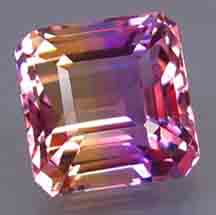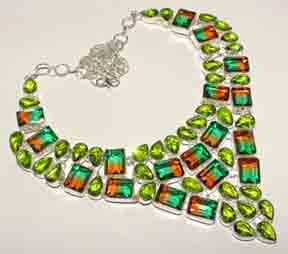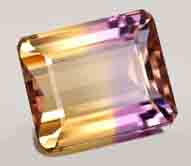
jrtltd.com

J.R.Truett Ltd. Inc
Gemstone Properties
Most people have never heard of
ametrine and are very surprised to see purple and yellow in a single
transparent gemstone. Ametrine is a rare gemstone produced in
only one mine in the world. It is a relative newcomer to the gemstone trade,
being available in small quantities for just a few decades.
Ametrine is a variety of bicolor quartz that has zones of amethyst (purple)
and citrine (golden yellow) in contact with one another in a single crystal.
The words AMEthyst and ciTRINE were combined to yield the name "ametrine,"
which is widely used in the gemstone trade. This material is known by other
less-frequently used names including: "amethyst-citrine," "trystine,"
"bicolor amethyst," "bicolor quartz," and "bolivianite." The bolivianite
name is a response to the material being designated as the national gemstone
of Bolivia.
AMETRINE
Part Topaz and part Amethyst
Comes in a verity of different colors

By Color

Mohs Hardness of 7 with a
trigonal crystal structure
Ametrine Also known as Trystine or by it’s trade name Bolivianite, Ametrine
is a naturally occurring variety of quartz.
It is a “mixture” of Amethyst and Citrine with zones of purple and of yellow
or orange, but yet being a crystal of it’s
own volition it is not just a mixture but a shade of it’s two cousins. Most
commercially available Ametrine is found in the
mines of Bolivia,
Geologists have theorized that
within the Anahi mine, just the specific type of heat was flowing in the
right
direction across a portion of the crystal to create just enough heat to
create the perfect balance of heat and
cool for the Ametrines to be formed. If the heat would have been any degree
higher or lower these lovelies would not exist.
The coloring is due to differing
oxidation of iron states within the crystal itself, which occurs due to a
temperature gradient
across the crystal during the time of it’s formation. In order for the Iron
to produce both colors within the same crystal, very
specific conditions must be present. Not only must there be two separate
temperature conditions, they must also remain
stable within the entire growth process of the crystal, which is an
incredible feat indeed.
Physical Properties of Ametrine
Color purple amethyst in contact with golden-yellow citrine
Streak colorless - harder than a streak plate
Luster vitreous
Diaphaneity translucent to transparent
Cleavage none - breaks with conchoidal fracture
Mohs Hardness 7
Specific Gravity 2.6 - 2.7
Chemical Composition SiO2
Diagnostic Characteristics conchoidal fracture, amethyst and citrine in a
single crystal
Crystal System hexagonal
Anahi Mine is the world's only
important source of natural ametrine and anahite
(a clear variety of quartz with a very light tint of lilac). The mine also
produces amethyst, citrine and bicolor
materials that are a combination of amethyst and clear quartz
(bicolor amethyst) or citrine and clear quartz (bicolor citrine)confirm for
themselves that the ametrine and citrine produced that are all natural
stones.
'a-m-a-trin
Natural color Stone
Stone of Revealing Joy
This multi-colored gemstone has more than a double color, it seems also to
have a double history and personality. Most geological references state that
Ametrine was first brought to the gem market in the 1970s. Except there
seems
to be another story about this special crystal that dates back to the
ancient Conquistadors stating quite a different story…
During the 17th century, a Conquistador named Don Felipe is said to have
married
Anakha, the princess to the Aureiros tribe of Bolivia. The mine, named for
Anahi in reverence
of the princess, was given to him as part of her dowry. When it came time
for Felipe to return to
Spain, his princess bride wished to return with him. But as the couple
attempted to depart, angry
tribesmen turned on them in anger and murdered the young princess. The dual
colored gem is said to
represent the princess’ two loyalties: to her husband as well as to her
tribe.
Metaphysical
Gemstone Properties
Ametrine is said to have all the metaphysical properties of both Amethyst
and Citrine combined, as well its own unique
properties. Ametrine energies are said to stimulate the intellect and
rid the aura of negative energy. Ametrine will help one recognize the
divinity within all, thus eliminating prejudice. It helps release old
programs in
the mind and attunes one to higher states of consciousness in meditation.
For those engaged in what may be considered mundane activities, Ametrine
teaches one to balance physical activities with one’s spiritual hunger.
Workaholics learn to pause and enjoy the fruits
that one’s labors provide. Procrastinators discover the empowering joy of
fully completing a task and the
rewards one reaps when a goal is
finally achieved. Those that walk among the clouds suddenly find
purpose in touching the Earth.
If one walks with fear, Ametrine
will reveal the hidden warrior within. If one moves with detailed precision,
executing well thought out plans, Ametrine will reveal the power of
serendipity and the joy from taking a chance.
When eyes are blind to the plight of others, Ametrine will help bring the
connection and responsibility we share with
every resident of our planet.
Associations: Venus/Air
Birthstone: Not a Birthstone for any month
Ametrine influence the needs and wishes of the individuals and helps resolve
inner contradictions. As it is told that the sign of Libra,
which was not recognized in early zodiacs, is the only zodiac sign to not be
represented by a living creature. Created in
Roman times it was meant to be a “balance” between Virgo & Scorpio
What Gives Ametrine Its Color?
The colors of amethyst and citrine are produced
by iron impurities with different oxidation states within
the quartz. Purple is thought to be produced by Fe3+ that is oxidized to
Fe4+ by natural radiation emitted
by the decay of potassium-40 in nearby rocks. The golden-yellow is thought
to be produced by Fe3+. [3]
If a well-formed ametrine crystal is sawn perpendicular to the c-axis, the
color zones of amethyst and citrine
often form a geometric pattern that radiates outwards from the c-axis like
the pieces of a pie.
Straight-line contacts
separate zones of amethyst from zones of citrine. This pattern is formed by
Brazil law twinning
in which two quartz crystals
of different color are inter grown to form the bicolor gemstone. [ It is
very
different from the bicolor zones of a tourmaline
crystal which form by sequential crystallization
New methods of cutting have
been developed to make maximum use of a finite ametrine resource. Some
stones are still cut in the traditional emerald
cut with a 50/50 amethyst/citrine split. Others are cut into "blended
ametrine" that has random or planned patches of amethyst and citrine. These
stones
are cut in orientations that allow light penetrating the stone to pass
through zones of purple amethyst and golden-yellow citrine. This can yield
beautiful stones
with face-up colors that include peach, magenta and orange.